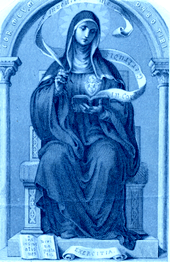Lives of the Saints
Our Models and Protectors
Spiritual Bouquet:
November 16

Saint Gertrude
Abbess of Eisleben
(1264-1334)
Saint Gertrude of Eisleben is the most celebrated of several Saints of the same name, and for this reason the ancient authors named her Gertrude the Great. She was born in the year 1264 of a noble Saxon family, and placed at the age of five for education with the Benedictines of Helfta. She dwelt there as a simple religious, very mistrustful of herself, under the direction of an Abbess having the same name as herself. The Abbess' sister was Saint Mechtilde of Hackeborn; and she was the mistress and friend of the young Saint Gertrude, who consulted her excellent teacher whenever she was tempted by vain and useless thoughts, or troubled by doubts suggested by the ancient enemy.
Saint Gertrude learned Latin in her youth, as in those days was customary for persons of her sex who consecrated themselves to God, and she wrote Latin with unusual elegance and force. She also had an uncommon knowledge of Holy Scripture and of all the branches of learning having religion as their object; but one day Our Lord reproached her with having too great a taste for her studies. Afterwards she could find in them nothing but bitterness; but soon Our Lord came to instruct her Himself. For many years she never lost His amiable Presence, save for eleven days when He decided to test her fidelity. Prayer and contemplation were her principal exercise, and to those she consecrated the greater part of her time.
Zeal for the salvation of souls was ardent in the heart of Gertrude. Thinking of the souls of sinners, she would shed torrents of tears at the foot of the cross and before the Blessed Sacrament. She especially loved to meditate on the Passion and the Eucharist, and at those times, too, could not restrain the tears that flowed in abundance from her eyes. When she spoke of Jesus Christ and His mysteries, she ravished those who heard her. One day while in church the Sisters were singing, I have seen the Lord face to face, Saint Gertrude beheld what appeared to be the divine Face, brilliant in beauty; His eyes pierced her heart and filled her soul and flesh with inexpressible delights. Divine love, ever the unique principle of her affections and her actions, was the principle by which she was crucified to the world and all its vanities.
She was the object of a great number of extraordinary graces; Jesus Christ engraved His wounds in the heart of His holy spouse, placed rings on her fingers, presented Himself to her in the company of His Mother, and in her spirit acted as though He had exchanged hearts with her. All these astonishing graces only developed her love for suffering. It was impossible for her to live without some kind of pain; the time she spent without suffering seemed to her to be wasted.
During the long illness of five months from which she would die, she gave not the slightest sign of impatience or sadness; her joy, on the contrary, increased with her pains. When the day of her death arrived in 1334, she saw the Most Blessed Virgin descend from heaven to assist her, and one of her Sisters perceived her soul going straight to the Heart of Jesus, which opened to receive it. Saint Gertrude is one of the great mystics of the Church; the book of her Revelations, recorded out of obedience, remains celebrated. In it she traces in words of indescribable beauty the intimate converse of her soul with Jesus and Mary. She was gentle to all, most gentle to sinners; filled with devotion to the Saints of God, to the souls in purgatory, and above all to the Passion of Our Lord and to His Sacred Heart.
Reflection: No preparation for death can be better than to offer and resign ourselves constantly to the Divine Will, humbly, lovingly, and with unbounded confidence in the infinite mercy and goodness of God.
Vie des Saints pour tous les jours de l'année, by Abbé L. Jaud (Mame: Tours, 1950); Little Pictorial Lives of the Saints, a compilation based on Butler's Lives of the Saints and other sources by John Gilmary Shea (Benziger Brothers: New York, 1894).